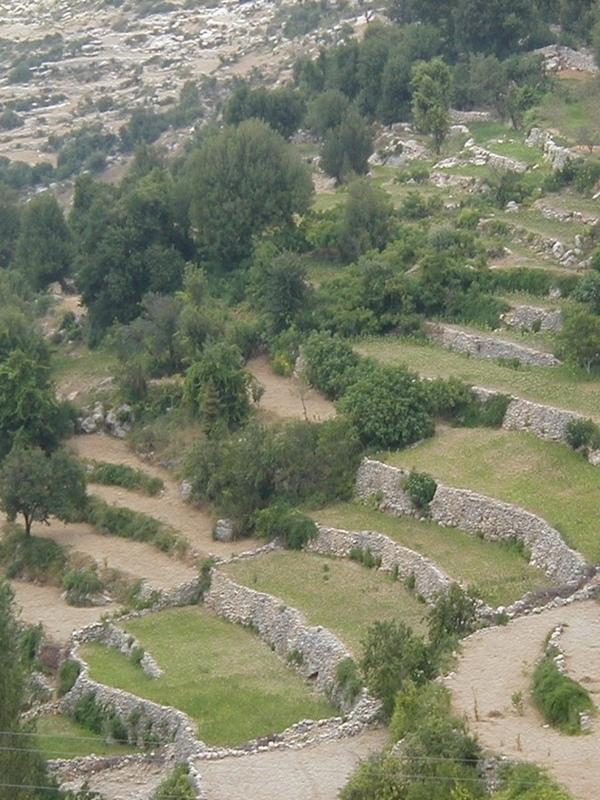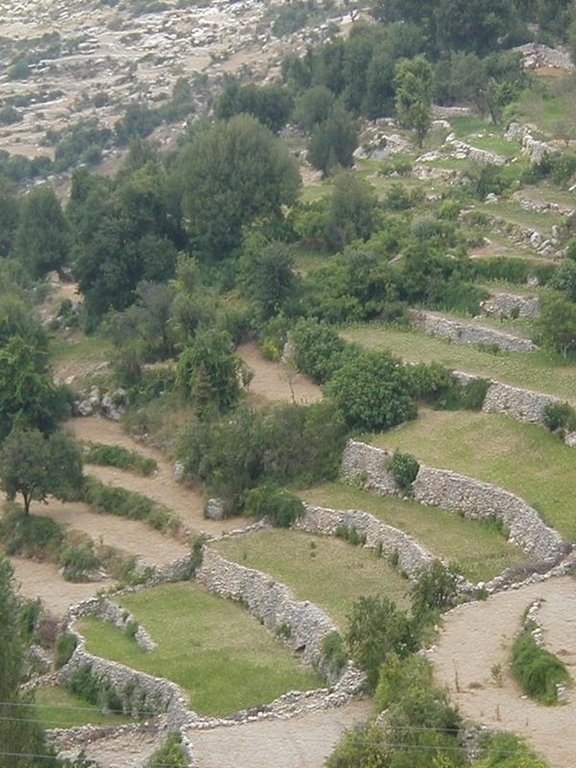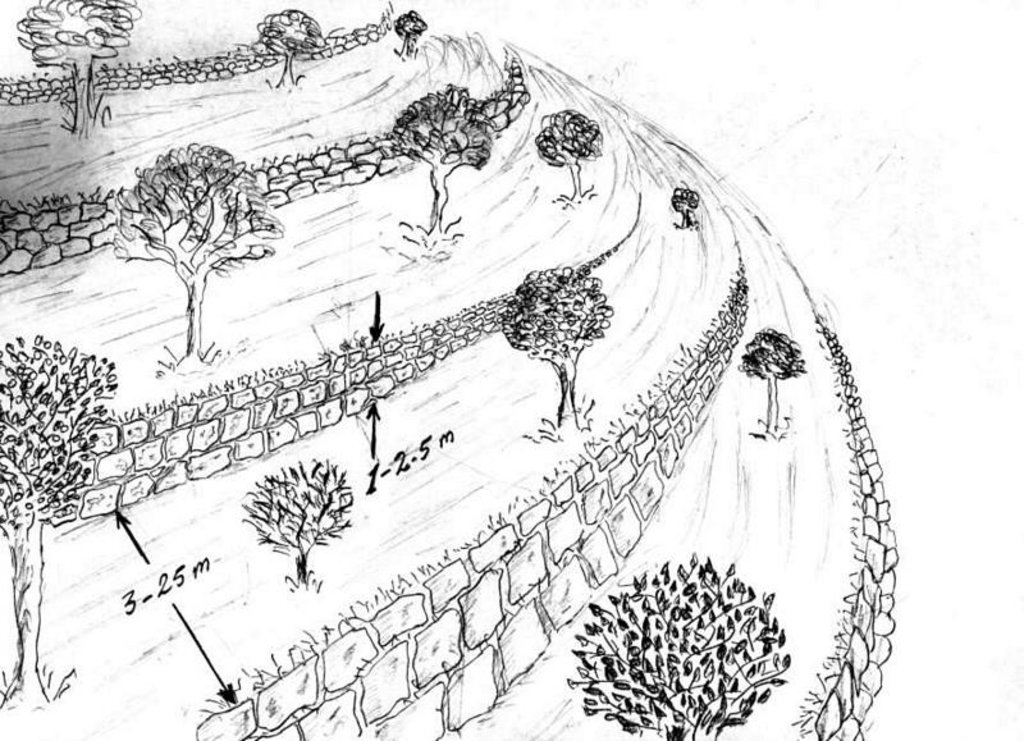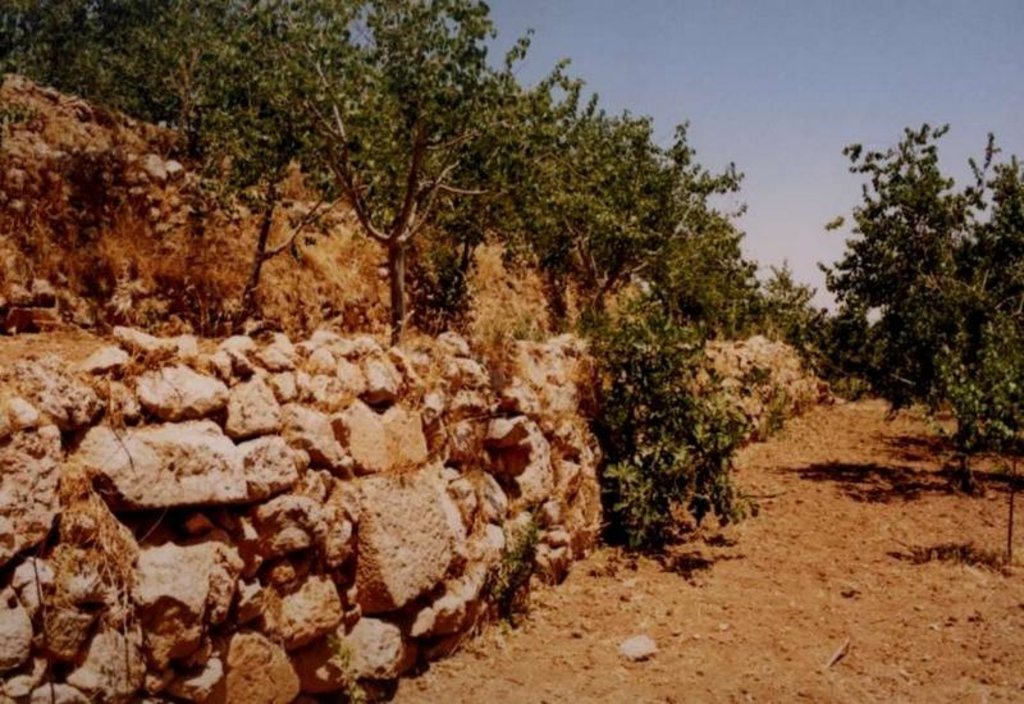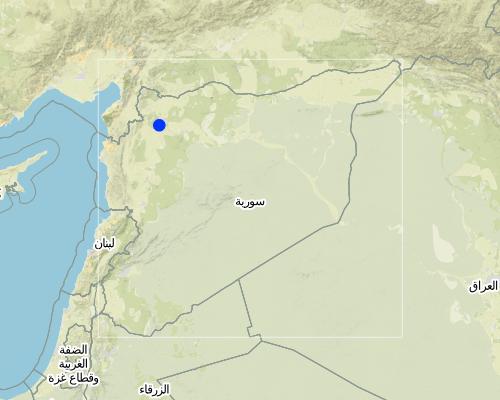Stone Wall Bench Terraces [Syrie]
- Création :
- Mise à jour :
- Compilateur : Michael Zoebisch
- Rédacteur : –
- Examinateur : Fabian Ottiger
Mudarrajad Hajaria (Arabic)
technologies_1411 - Syrie
Voir les sections
Développer tout Réduire tout1. Informations générales
1.2 Coordonnées des personnes-ressources et des institutions impliquées dans l'évaluation et la documentation de la Technologie
Spécialiste GDT:
Spécialiste GDT:
Spécialiste GDT:
Spécialiste GDT:
Spécialiste GDT:
Salem Salwa
ICARDA Syria
P.O.Box 5466, Aleppo
Syrie
Nom du projet qui a facilité la documentation/ l'évaluation de la Technologie (si pertinent)
Book project: where the land is greener - Case Studies and Analysis of Soil and Water Conservation Initiatives Worldwide (where the land is greener)Nom du ou des institutions qui ont facilité la documentation/ l'évaluation de la Technologie (si pertinent)
International Center for Agricultural Research in the Dry Areas (ICARDA) - Liban1.3 Conditions relatives à l'utilisation par WOCAT des données documentées
Quand les données ont-elles été compilées (sur le terrain)?
23/08/1999
Le compilateur et la(les) personne(s) ressource(s) acceptent les conditions relatives à l'utilisation par WOCAT des données documentées:
Oui
2. Description de la Technologie de GDT
2.1 Courte description de la Technologie
Définition de la Technologie:
Ancient level bench terraces with stone walls, built to stabilise slopes, retain moisture, and create a suitable environment for horticulture.
2.2 Description détaillée de la Technologie
Description:
Stone wall bench terraces in the hill ranges of western Syria comprise an ancient indigenous technology, introduced by the Romans and Byzantines about 2,000 years ago. Some new terraces are, however, still being built. The walls are constructed with limestone, largely found on site. The terraces are located in steep terrain (usually on slopes more than 25%) under low (and erratic) rainfall regimes of between 250 and 500 mm per annum. The terrace walls are 1-2.5 m high and the level beds 3-25 m wide, depending on slope.
Deep soil profiles (more than 2 m) have developed on steep slopes, where original soil depth was only shallow to medium. The terraces are very efficient in preventing soil erosion and in the retention of rainfall. They support trees and annual crops where they could not otherwise be grown.
These terraces are usually found near settlements. Construction is very labour intensive, considering how little land is effectively protected from erosion and brought into cultivation. High labour investment makes the construction process slow and retards further extension of the technology. However, if soundly constructed, maintenance requirements are low. Underlining this point, a large number of very ancient terraces can still be found intact, supporting a productive crop. Sometimes localised collapse of a terrace occurs due to concentrated runoff. In that case, the terrace in question may need to be rebuilt. To prevent such breaches, it is important to allow for discharge of excess runoff along drainage lines.
Currently, most terraces are used to grow fruit trees. These include olives, cherries, almonds, plums, pomegranates, apricots, and peaches. Husbandry practices are normally carried out by hand. Where space permits, however, draft animals are used for tillage. The curves of the terraces and access to the steep slopes make it very difficult/impossible to use tractors. Animal power is more versatile in this irregular landscape, but it is more expensive than tractor power, due to shortage of fodder.
2.3 Photos de la Technologie
2.5 Pays/ région/ lieux où la Technologie a été appliquée et qui sont couverts par cette évaluation
Pays:
Syrie
Région/ Etat/ Province:
Idleb Province, Ariha District
Autres spécifications du lieu:
Tal Lata Village
Map
×2.6 Date de mise en œuvre de la Technologie
Si l'année précise est inconnue, indiquez la date approximative: :
- il y a plus de 50 ans (technologie traditionnelle)
2.7 Introduction de la Technologie
Spécifiez comment la Technologie a été introduite: :
- dans le cadre d'un système traditionnel (> 50 ans)
Commentaires (type de projet, etc.) :
The technology was most probably developed and introduced during the Roman/Byzantine period, 200-400 AD
3. Classification de la Technologie de GDT
3.1 Principal(aux) objectif(s) de la Technologie
- améliorer la production
- créer un impact économique positif
3.2 Type(s) actuel(s) d'utilisation des terres, là où la Technologie est appliquée

Terres cultivées
- Plantations d’arbres ou de buissons
Principales cultures (vivrières et commerciales):
Major cash crop: Fruits (olives, cherries, almonds, plums, pomegran
Commentaires:
Major land use problems (compiler’s opinion): Before terracing, water erosion resulted in shallow to medium colluvial soils. Terracing made cultivation possible, but the
beds tend to be very narrow and/or irregularly shaped, with large boulders set in them, making tractor cultivation (which is cheap) impossible.
Major land use problems (land users’ perception): (1) Soil tillage - mechanization is difficult; animal power is up to 5 times more expensive than tractor power.
(2) Rockiness of the soil - large and very large stones make cultivation difficult.
(3) Accessibility - inadequate road network to reach fields
3.3 Informations complémentaires sur l'utilisation des terres
Approvisionnement en eau des terres sur lesquelles est appliquée la Technologie:
- pluvial
Nombre de période de croissance par an: :
- 1
Précisez:
Longest growing period in days: 180 Longest growing period from month to month: Nov - Apr
3.4 Groupe de GDT auquel appartient la Technologie
- mesures en travers de la pente
3.5 Diffusion de la Technologie
Spécifiez la diffusion de la Technologie:
- répartie uniformément sur une zone
Si la Technologie est uniformément répartie sur une zone, indiquez la superficie couverte approximative:
- 1-10 km2
Commentaires:
Total area covered by the SLM Technology is 5 km2.
Recently, new stone wall bench terraces have been constructed in the villages of Mnabe and Bzbour (Ariha District)
3.6 Mesures de GDT constituant la Technologie
3.7 Principaux types de dégradation des terres traités par la Technologie

érosion hydrique des sols
- Wt: perte de la couche superficielle des sols (couche arable)/ érosion de surface

dégradation hydrique
- Ha: aridification
Commentaires:
Main type of degradation addressed: Wt: loss of topsoil / surface erosion, Ha: aridification
3.8 Prévention, réduction de la dégradation ou réhabilitation des terres dégradées
Spécifiez l'objectif de la Technologie au regard de la dégradation des terres:
- prévenir la dégradation des terres
4. Spécifications techniques, activités, intrants et coûts de mise en œuvre
4.1 Dessin technique de la Technologie
4.2 Spécification/ explications techniques du dessin technique
Stone wall risers constructed in ancient times: these hold back the earth for production of fruit trees on the level benches.
Technical knowledge required for field staff / advisors: high
Technical knowledge required for land users: high
Main technical functions: reduction of slope angle, increase of infiltration, water harvesting / increase water supply, increase in soil fertility (long-term)
Secondary technical functions: increase / maintain water stored in soil, sediment retention / trapping, sediment harvesting, control of concentrated runoff
Terrace: bench level
Vertical interval between structures (m): 1-2
Spacing between structures (m): 2-25
Construction material (stone): natural stones (limestone)
Slope (which determines the spacing indicated above): 20%
For water harvesting: the ratio between the area where the harvested water is applied and the total area from which water is collected is: 1:1
4.3 Informations générales sur le calcul des intrants et des coûts
autre/ monnaie nationale (précisez):
Syrian Pounds
Indiquer le taux de change du dollars en monnaie locale (si pertinent): 1 USD= :
50,0
Indiquez le coût salarial moyen de la main d'œuvre par jour:
3.00
4.4 Activités de mise en place/ d'établissement
| Activité | Type de mesures | Calendrier | |
|---|---|---|---|
| 1. | Levelling the terrace bed by bulldozers where necessary. | Structurel | 0.35-0.7 persondays/m for all activities |
| 2. | Blasting rocks in the field | Structurel | |
| 3. | Collecting stones for wall building – which are available locally. | Structurel | |
| 4. | Building the stone walls with 1–2.5 m vertical interval (and therefore | Structurel | |
| 5. | Levelling land between stone walls. | Structurel |
4.5 Coûts et intrants nécessaires à la mise en place
| Spécifiez les intrants | Unité | Quantité | Coûts par unité | Coût total par intrant | % des coût supporté par les exploitants des terres | |
|---|---|---|---|---|---|---|
| Main d'œuvre | Labour | ha | 1,0 | 1260,0 | 1260,0 | 100,0 |
| Main d'œuvre | Stone collection | ha | 1,0 | 50,0 | 50,0 | 100,0 |
| Equipements | Machine use | ha | 1,0 | 50,0 | 50,0 | 100,0 |
| Equipements | Tools | ha | 1,0 | 50,0 | 50,0 | 100,0 |
| Equipements | Drill | ha | 1,0 | 5,0 | 5,0 | 100,0 |
| Engrais et biocides | Ammonium nitrate(kg) | ha | 1,0 | 15,0 | 15,0 | 100,0 |
| Matériaux de construction | Stone | ha | 1,0 | |||
| Matériaux de construction | Detonators | ha | 1,0 | 10,0 | 10,0 | 100,0 |
| Matériaux de construction | Fuses (m) | ha | 1,0 | 20,0 | 20,0 | 100,0 |
| Coût total de mise en place de la Technologie | 1460,0 | |||||
Commentaires:
Duration of establishment phase: 6 month(s)
4.6 Activités d'entretien/ récurrentes
| Activité | Type de mesures | Calendrier/ fréquence | |
|---|---|---|---|
| 1. | Repairing (replacing stones) | Structurel | 5 persondays required/every year |
4.7 Coûts et intrants nécessaires aux activités d'entretien/ récurrentes (par an)
| Spécifiez les intrants | Unité | Quantité | Coûts par unité | Coût total par intrant | % des coût supporté par les exploitants des terres | |
|---|---|---|---|---|---|---|
| Main d'œuvre | Labour | ha | 1,0 | 15,0 | 15,0 | 100,0 |
| Equipements | Tools | ha | 1,0 | 5,0 | 5,0 | 100,0 |
| Matériaux de construction | Stone | ha | 1,0 | |||
| Coût total d'entretien de la Technologie | 20,0 | |||||
Commentaires:
Manual construction work requires 0.35-0.7 person days per metre length of terrace wall. Establishment costs were calculated for an average of 600 m length of stone wall (height 2 m, width 70 cm) per hectare on a 12% slope, with
terrace beds therefore about 16-17 metres wide. Narrower terraces on steeper slopes are considerably more expensive to construct.
4.8 Facteurs les plus importants affectant les coûts
Décrivez les facteurs les plus importants affectant les coûts :
Labour shortage and labour cost
5. Environnement naturel et humain
5.1 Climat
Précipitations annuelles
- < 250 mm
- 251-500 mm
- 501-750 mm
- 751-1000 mm
- 1001-1500 mm
- 1501-2000 mm
- 2001-3000 mm
- 3001-4000 mm
- > 4000 mm
Zone agro-climatique
- semi-aride
5.2 Topographie
Pentes moyennes:
- plat (0-2 %)
- faible (3-5%)
- modéré (6-10%)
- onduleux (11-15%)
- vallonné (16-30%)
- raide (31-60%)
- très raide (>60%)
Reliefs:
- plateaux/ plaines
- crêtes
- flancs/ pentes de montagne
- flancs/ pentes de colline
- piémonts/ glacis (bas de pente)
- fonds de vallée/bas-fonds
Zones altitudinales:
- 0-100 m
- 101-500 m
- 501-1000 m
- 1001-1500 m
- 1501-2000 m
- 2001-2500 m
- 2501-3000 m
- 3001-4000 m
- > 4000 m
Commentaires et précisions supplémentaires sur la topographie:
Slopes on average: Also rolling (ranked 3)
5.3 Sols
Profondeur moyenne du sol:
- très superficiel (0-20 cm)
- superficiel (21-50 cm)
- modérément profond (51-80 cm)
- profond (81-120 cm)
- très profond (>120 cm)
Texture du sol (de la couche arable):
- moyen (limoneux)
- fin/ lourd (argile)
Matière organique de la couche arable:
- moyen (1-3%)
Si disponible, joignez une description complète du sol ou précisez les informations disponibles, par ex., type de sol, pH/ acidité du sol, capacité d'échange cationique, azote, salinité, etc.
Soil fertility: Medium (ranked 1) and low (ranked 2)
Soil drainage/infiltration: Medium
Soil water storage capacity: Medium
5.6 Caractéristiques des exploitants des terres appliquant la Technologie
Orientation du système de production:
- mixte (de subsistance/ commercial)
- commercial/ de marché
Revenus hors exploitation:
- > 50% de tous les revenus
Niveau de mécanisation:
- travail manuel
- traction animale
Indiquez toute autre caractéristique pertinente des exploitants des terres:
Population density: > 500 persons/km2
Annual population growth: 3% - 4%
Relative level of wealth: very rich, rich, average, poor
3% of the land users are very rich and own 20% of the land (very few).
7% of the land users are rich and own 20% of the land (few,).
40% of the land users are average wealthy and own 30% of the land (Many).
50% of the land users are poor and own 30% of the land (Many).
Off-farm income specification: On average, 70 % of the income is from off-farm activities
5.7 Superficie moyenne des terres détenues ou louées par les exploitants appliquant la Technologie
- < 0,5 ha
- 0,5-1 ha
- 1-2 ha
- 2-5 ha
- 5-15 ha
- 15-50 ha
- 50-100 ha
- 100-500 ha
- 500-1 000 ha
- 1 000-10 000 ha
- > 10 000 ha
Commentaires:
The overall range is 0.5-7 ha
5.8 Propriété foncière, droits d’utilisation des terres et de l'eau
Propriété foncière:
- individu, avec titre de propriété
Droits d’utilisation des terres:
- individuel
6. Impacts et conclusions
6.1 Impacts sur site que la Technologie a montrés
Impacts socio-économiques
Production
production agricole
qualité des fourrages
production de bois
gestion des terres
Revenus et coûts
revenus agricoles
charge de travail
Commentaires/ spécifiez:
Mechanisation is not possible
Impacts socioculturels
institutions communautaires
institutions nationales
apaisement des conflits
Commentaires/ spécifiez:
But a potential for conflict if the community refuses to participate in joint maintenance activities
Impacts écologiques
Cycle de l'eau/ ruissellement
drainage de l'excès d'eau
Sols
humidité du sol
couverture du sol
perte en sol
cycle/ recharge des éléments nutritifs
Biodiversité: végétale, animale
diversité végétale
diversité animale
diversité des habitats
Réduction des risques de catastrophe et des risques climatiques
vitesse du vent
6.2 Impacts hors site que la Technologie a montrés
inondations en aval
envasement en aval
pollution des rivières/ nappes phréatiques
6.4 Analyse coûts-bénéfices
Quels sont les bénéfices comparativement aux coûts de mise en place (du point de vue des exploitants des terres)?
Rentabilité à court terme:
négative
Rentabilité à long terme:
positive
Quels sont les bénéfices comparativement aux coûts d'entretien récurrents (du point de vue des exploitants des terres)?
Rentabilité à court terme:
positive
Rentabilité à long terme:
positive
6.5 Adoption de la Technologie
Si disponible, quantifiez (nombre de ménages et/ou superficie couverte):
39
Commentaires:
5% of land user families have adopted the Technology with external material support
2 land user families have adopted the Technology with external material support
95% of land user families have adopted the Technology without any external material support
37 land user families have adopted the Technology without any external material support
There is no trend towards spontaneous adoption of the Technology
Comments on adoption trend: The rate of spontaneous adoption is low because of the high costs.
6.7 Points forts/ avantages/ possibilités de la Technologie
| Points forts/ avantages/ possibilités du point de vue du compilateur ou d'une autre personne ressource clé |
|---|
|
Soil and water is conserved and fruit crop yields are maintained/increased How can they be sustained / enhanced? Combine with soil fertility improvement (such as farm yard manure). The prices of the crops grown should remain adequate |
|
The maintenance requirements are low. The terraces need little repair How can they be sustained / enhanced? Natural drainage lines must be prepared/maintained to prevent collapse during heavy rainfall. |
| The terraces make the cultivation of trees on hill slopes possible. |
6.8 Faiblesses/ inconvénients/ risques de la Technologie et moyens de les surmonter
| Faiblesses/ inconvénients/ risques du point de vue du compilateur ou d'une autre personne ressource clé | Comment peuvent-ils être surmontés? |
|---|---|
| The establishment costs are high | Plant high value cash crops. |
| The mechanisation of farm operations is impossible because there is no access to the terraces for tractors, while animal power is constrained by high maintenance costs (fodder). Thus, field operations are limited to hand labour | Subsidise mule ploughing. |
7. Références et liens
7.2 Références des publications disponibles
Titre, auteur, année, ISBN:
Mushallah AB. The visible and the hidden in the country of olives. pp 463. 2000.
Disponible à partir d'où? Coût?
Akrama Publ. Office. Damascus, Syria.
Liens et modules
Développer tout Réduire toutLiens
Aucun lien
Modules
Aucun module trouvé


